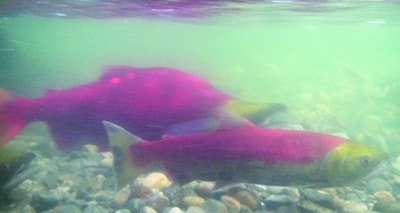Kamloops This Week
Planning for a forecasted record inland fishery on Kamloops Lake continues in the wake of the Mount Polley mine disaster, which is not expected to alter the harvest.
The tailings breach caused several First Nations bands in the Lillooet area downstream on the Fraser River to close a traditional food fishery on Aug. 9, but further water-quality testing has found no contaminated samples.
On Aug. 4, the tailings dam at the open-pit mine near Likely collapsed, sending millions of litres of water into Polley Lake and then into Quesnel Lake, which feeds the Fraser River system.
The breach came just weeks before the start of the Fraser sockeye run, expected to see more than 20-million salmon re-enter the system to spawn, including at Adams and Quesnel rivers.
Murray Ross, who heads the Secwepemc Fisheries Commission, said the tailings breach brought some initial uncertainty to the unique inland fishery, which sees a contracted boat on Kamloops Lake harvest for commercial purposes.
It is still planning to begin netting sockeye beginning as early as Aug. 18.
“We’ve ramped up our fishing effort compared to 2010 [the record brood year]. We have the opportunity for a second boat if we’re catching lots of fish.”
On Monday, provincial officials said water-quality testing on Polley and Quesnel lakes has found all samples are safe for human consumption and vary little from normal conditions.
The commission advises Shuswap bands on fisheries issues, including for traditional food fishing. Ross met on Monday, Aug. 11, with representatives of the Adams Lake Indian Band to report they should be OK to resume traditional fishing activities.
“I don’t think we need to have as much caution as a week ago. [But] there are still concerns and long-term issues we will have to deal with.”
Ross said he is heartened by early results of water testing as well as plans to test at the confluence of the Quesnel and Fraser rivers.
Environmental testing has shown the vast majority of water samples have come back at safe levels, according to Canadian Drinking Water Guidelines, stated a release from the Ministry of Environment:
“Water samples taken by Imperial Metals from the shore of Polley Lake on Aug. 7, 2014, have been tested and are very close to historical levels prior to the breach of the tailings pond.”
But, late last week, several bands along the Fraser reported finding salmon with skin that could be wiped off by hand.
“It’s not a risk worth taking,” said Xaxli’p First Nation chief Darrell Bob, who complained there has been no local testing by health or Department of Fisheries officials in the wake of the Mount Polley disaster.
Many families depend on the traditional harvest, whether by spear or dip net.
Bob said the uncertainty is too great and government officials have been silent.
“We haven’t heard from anybody,” he complained.
On Monday at Kamloops Lake, crews started building a dock, part of new infrastructure intended to land fish and get them on ice and to market more quickly.
The inland fishery hopes to net upwards of 250,000 returning sockeye using two boats on Kamloops Lake.
